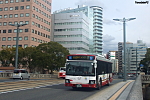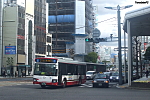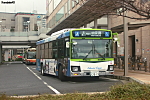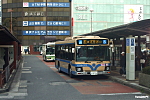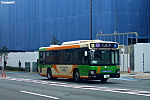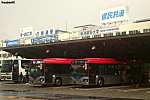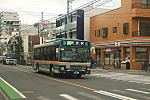Not logged in | Log in | Sign Up

Search Photos
Isuzu QDG-LV290N1 Erga Non-Step #240
14 february 2019 - Hiroshima, Inari-ōhashi (広島県広島市稲荷大橋).25: 広島駅 (Hiroshima-eki) → 井口車庫 (Inokuchi-shako)
If I am to believe Japanese Wikipedia, a portion of this company`s fleet is made up of used buses bought from the capital region. While the Erga in the photo is not one of those - having been bought brand new - it`s still curious as to why the Hiroshima-based company wasn`t seeking its fleet somewhere closer, for example in the Keihanshin area. On the other hand I`m under the impression that fleet replacement is going somewhat faster in the capital region, even if there isn`t really a push in Japan to operate low-floor only services.
Speaking of low-floor services, rte 25 is the only route of this company where departures scheduled to be operated by low-floor buses are marked. This is also particularly rare in Japan.


Author: TranslatorPS 

Isuzu QDG-LV290N1 Erga Non-Step #195
14 february 2019 - Hiroshima, Naka-ku, Ebisuchō (広島県広島市中区恵美須町).21-2: 広島駅 (Hiroshima-eki) → 広島港 (Hiroshima-minato)
To go along with the other photo, the typical version of rte 21 on its eastern half. The 八丁堀 Hatchōbori sheet doesn`t indicate a variation - all 21 trips go through this junction after all - but it`s more likely to serve to highlight that this route serves this major transfer point to begin with.


Author: TranslatorPS 

Isuzu QPG-LV290N1 Erga Non-Step #3100
13 december 2018 - Shiki (Pref. Saitama), Honchō 5-chōme (埼玉県志木市本町5丁目), plac terminala autobusowego Shiki-eki Higashi-guchi.志05-3 (shi-05-3): 志木駅東口 (Shiki Station East Exit) → 中宗岡 (Naka-muneoka)
Pod zdjęciem 1064849 pada stwierdzenie, jakoby przewozy po japońskiej aglomeracji stołecznej to była głównie kwestia kolei. Sprostujmy więc lekko temat. Według statystyk podanych przez ministerstwo odpowiednie ds. transportu, w 2010 roku było 385 tys. użytkowników autobusowych biletów okresowych w aglomeracji stołecznej. Oczywiście przy dziennych 40 milionach pasażerów kolejowych oraz 8,5 milionach sprzedanych kolejowych biletów okresowych jest to naprawdę słaba liczba (ledwie niecały 1% użytkowników i prawie 4,5% posiadaczy), ale trzeba wziąć pod uwagę, że odsetek pasażerów korzystających z biletów okresowych w porównaniu do wszystkich jest zaskakująco niski (w 2010 r. w dojeździe do pracy 31% wszystkich pasażerów kontra 60% płacących z e-portmonetek). Kluczowy jest w tym fakt, że wiele dojeżdżających do pracy lub szkoły i jednocześnie korzystających z kolei dystans "ostatniej mili" pokonuje również innymi środkami, jak np. na rowerze (a ile mnie już takich prawie do szpitala zesłało!), czy też na piechotę. W porannym szczycie powszednim pomiędzy 70% a 95% korzystających z autobusów to dojeżdżający do pracy lub szkoły - liczba ta zmienia się zależnie od terminala autobusowego, natomiast ok. 60% wzwyż z tych osób korzysta z autobusów 5 dni w tygodniu, a ogólnie pasażerów regularnych (przynajmniej 2 dni w tygodniu) będzie pomiędzy 80% a 90%. Skalę autobusowych przewozów pasażerskich niech pokaże jednak jeszcze jedna kwestia, którą policzyłem już ja na podstawie informacji na stronach przewoźników. Wybrawszy z niemal setki przewoźników istniejących w aglomeracji tokijskiej kluczowe 18, tylko 14 z nich miało co prawda takową statystykę, ale te 14 firm razem wziętych posiadało na stanie, wliczając również pojazdy dalekobieżne - niespełna 11800 pojazdów. Obrazki więc jak ten wyżej - kilku ładujących pasażerów pojazdów, często wielu firm, są nie dość że uzasadnione, to bezsprzecznie częste... i potrzebne w funkcjonowaniu tego unikatowego organizmu. Brak angielskiego opisu celowy.

Author: TranslatorPS 

Comments: 6
Isuzu 2DG-LV290N2 Erga Non-Step #7-1826
25 january 2019 - Yokohama (Kanagawa Pref.), Nishi-ku, Minami-saiwai 1-chōme (神奈川県横浜市西区南幸1丁目), Yokohama-eki Nishi-guchi bus terminal.87: 横浜駅西口 (Yokohama Station West Exit) → 市民病院 (City Hospital) → 横浜駅西口 (Yokohama Station West Exit) (circular route)
Is this a normal route number? Yes! Yokohama City Bureau of Transportation does NOT use kanji characters in its route numbering. The number and scale of bus operations in Yokohama is slightly mind-numbing, but one way or another you got to somehow cover a 3.73 million population city, which aside from its metric ton of standard-length buses (!!) otherwise only relies on JR, Keikyū, Tōkyū, Sōtetsu, and its own two subway lines. A bit of interesting trivia about Yokohama: as an administrative unit, Yokohama-shi is the most populous city in Japan, however that`s not the case as a general urban unit, in which case it places second - if we can even consider the possibility of splitting out anyting in the wider Kantō agglomeration aside from arbitrary borders.


Author: TranslatorPS 

Comments: 2
Isuzu 2DG-LV290N2 Erga Non-Step #P-D302
25 december 2018 - Tōkyō, Bunkyō-ku, Ōtsuka 2-chōme (東京都文京区大塚2丁目), National Route 254.都02 (to-02): 錦糸町駅前 (Kinshichō Station) → 大塚駅前 (Ōtsuka Station)
Today`s topic is a short series of Toei buses. I think it would be worthwhile to explain what Toei actually is. It is in fact a section (bureau) of the metropolitan government of Tōkyō. To lay it over British terms, it`s as if the Greater London Assembly planned and operated the bus services directly using its own buses and hiring its own drivers (not even with TfL, but literally as an office out of the GLA). When referring to the Tōkyō metropolis it`s important to note that I`m referring to the prefectural-level body - Tōkyō city as a local government body ceased to exist in 1943. Perhaps it`s a slightly strange arrangement, but Japan just about doesn`t have tendering and contracting processes in public transport (at least as far as I know) - it`s either one of the 28 local government transport bureaus, or private operators, which are one way or another often tied to one of the railway conglomerates.


Isuzu QDG-LV290N1 Erga Non-Step #R-B771
14 september 2018 - Tōkyō, Edogawa-ku, Naka-kasai 5-chōme (東京都江戸川区中葛西5丁目), bus terminus adjacent to Kasai metro station.秋26 (aki-26): 葛西駅前 (Kasai Station) → 秋葉原駅前 (Akihabara Station)
Apparently you can get to Akihabara on this bus. So far, true, but whether this thing`s got a set frequency is another story. Mondays to Fridays it sports a solid morning peak at every 6-10 minutes, interpeak at every 26-28, and an afternoon peak at every 19-21, or maybe 15-16. On Saturdays it runs apparently every 19-21 minutes in the morning, but later every 23-24. Only on Sundays does it run every 20 minutes for most of the day. What of it, however, if the last departures are before 10pm? That`s how most more frequent city bus routes look like in Japan: most companies don`t know what a set frequency is, never mind synchronisation modules, and above all, departures after 22:30 are rare beyond rare.


Isuzu 2PG-LV290Q2 Erga Non-Step #H1127-I
30 december 2018 - Niigata (Niigata Pref.), Chūō-ku, Hanazono 1-chōme, bus station located in front of Niigata railway station (新潟県新潟市中央区花園1丁目).C31: 新潟駅前 (Niigata Station) → 西部営業所 (Seibu Depot)
Back to Niigata we go... Two Ergas (titular and H1047-I on rte W22) and another I-have-no-idea-what-it-is are loading passengers at the stands of Niigata-eki-mae bus stop. As seen in the photo, the buses are reversed into the stand entrances, which is good in terms of pulling out from the station, as well as given that passengers board via the back doors.
The bus network is built such that routes that operate mostly within the city terminate here. However, routes that operate outside of the built-up areas but still operated with city buses serve this stop en-route. Since they serve these reverse-entry stands, buses arriving here reverse in service with passengers on-board. However, staff on-site assist with the reversing process; they are also the ones to permit pax to enter the stand area. I don`t have any photos worth publishing from the reversing itself, however. The snow comes as a bonus.


Author: TranslatorPS 

Comments: 1
Isuzu 2PG-LV290N2 Erga Non-Step #A8-726
16 may 2019 - Niiza (Saitama Pref.), Higashi 2-chōme (埼玉県新座市東2丁目), Prefectural Route 40, at around Rikkyō-mae stop.清61 (kiyo-61): 志木駅南口 (Shiki Station South Exit) → 清瀬駅北口 (Kiyose Station North Exit)
This photo may seem random, but it`s mostly for the sake of trivia. For the first time in 67 years, Seibu Bus is changing its route bus livery. You can see the new template at these URLs: sides, front and back. I dare say it`s nothing more than the sprayman`s nightmare, but I imagine they have already come up with a solution for that. The paintjob needs the refreshment (the current template is showing its age), and you can also see the grey and blue which have recently dominated the mother company`s rail stock.


Author: TranslatorPS 

Isuzu QDG-LV290N1 Erga Non-Step #A6-954
13 december 2018 - Niiza City (Saitama Pref.), Tōhoku 2-chōme (埼玉県新座市東北2丁目), Prefectural Route 40. With that said, I`d like to say hello :) I hope to add worthwhile content to this photogallery.志33-1 (shi-33-1): 志木駅南口 (Shiki Station South Exit) → 新座駅南口 (Niiza Station South Exit)
With this photo, I think I can summarise the essence of Japanese suburbs quite well: not the widest streets (sidewalk not compulsory), completely mixed high-rise and low buildings, mandatory kombini in a relatively accessible distance (here: 7-Eleven), wiring out in the open, at least a few bicycles within eye`s reach, and along the afore-mentioned street a local city buses passes quite regularly (or not), whose purpose is a feeder to the closest railway station or stop. Sleepertown, no more, no less.


Author: TranslatorPS 

Comments: 5
